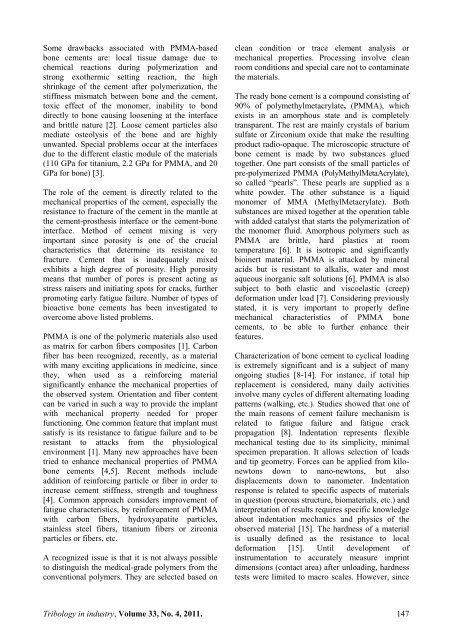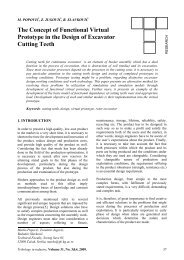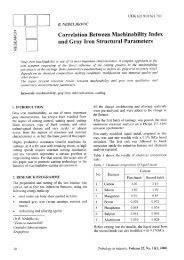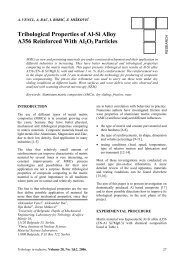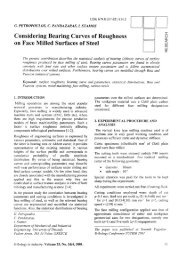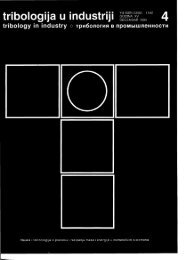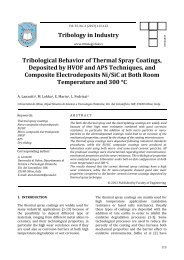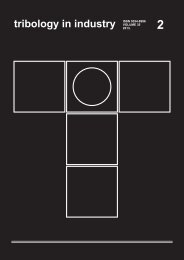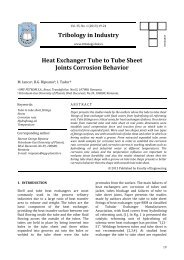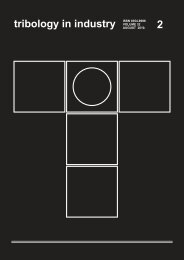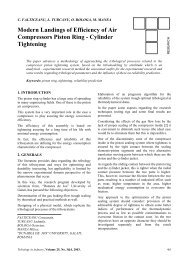(PMMA) Based Bone Cement - Tribology in Industry
(PMMA) Based Bone Cement - Tribology in Industry
(PMMA) Based Bone Cement - Tribology in Industry
Create successful ePaper yourself
Turn your PDF publications into a flip-book with our unique Google optimized e-Paper software.
Some drawbacks associated with <strong>PMMA</strong>-basedbone cements are: local tissue damage due tochemical reactions dur<strong>in</strong>g polymerization andstrong exothermic sett<strong>in</strong>g reaction, the highshr<strong>in</strong>kage of the cement after polymerization, thestiffness mismatch between bone and the cement,toxic effect of the monomer, <strong>in</strong>ability to bonddirectly to bone caus<strong>in</strong>g loosen<strong>in</strong>g at the <strong>in</strong>terfaceand brittle nature [2]. Loose cement particles alsomediate osteolysis of the bone and are highlyunwanted. Special problems occur at the <strong>in</strong>terfacesdue to the different elastic module of the materials(110 GPa for titanium, 2.2 GPa for <strong>PMMA</strong>, and 20GPa for bone) [3].The role of the cement is directly related to themechanical properties of the cement, especially theresistance to fracture of the cement <strong>in</strong> the mantle atthe cement-prosthesis <strong>in</strong>terface or the cement-bone<strong>in</strong>terface. Method of cement mix<strong>in</strong>g is veryimportant s<strong>in</strong>ce porosity is one of the crucialcharacteristics that determ<strong>in</strong>e its resistance tofracture. <strong>Cement</strong> that is <strong>in</strong>adequately mixedexhibits a high degree of porosity. High porositymeans that number of pores is present act<strong>in</strong>g asstress raisers and <strong>in</strong>itiat<strong>in</strong>g spots for cracks, furtherpromot<strong>in</strong>g early fatigue failure. Number of types ofbioactive bone cements has been <strong>in</strong>vestigated toovercome above listed problems.<strong>PMMA</strong> is one of the polymeric materials also usedas matrix for carbon fibers composites [1]. Carbonfiber has been recognized, recently, as a materialwith many excit<strong>in</strong>g applications <strong>in</strong> medic<strong>in</strong>e, s<strong>in</strong>cethey, when used as a re<strong>in</strong>forc<strong>in</strong>g materialsignificantly enhance the mechanical properties ofthe observed system. Orientation and fiber contentcan be varied <strong>in</strong> such a way to provide the implantwith mechanical property needed for properfunction<strong>in</strong>g. One common feature that implant mustsatisfy is its resistance to fatigue failure and to beresistant to attacks from the physiologicalenvironment [1]. Many new approaches have beentried to enhance mechanical properties of <strong>PMMA</strong>bone cements [4,5]. Recent methods <strong>in</strong>cludeaddition of re<strong>in</strong>forc<strong>in</strong>g particle or fiber <strong>in</strong> order to<strong>in</strong>crease cement stiffness, strength and toughness[4]. Common approach considers improvement offatigue characteristics, by re<strong>in</strong>forcement of <strong>PMMA</strong>with carbon fibers, hydroxyapatite particles,sta<strong>in</strong>less steel fibers, titanium fibers or zirconiaparticles or fibers, etc.A recognized issue is that it is not always possibleto dist<strong>in</strong>guish the medical-grade polymers from theconventional polymers. They are selected based onclean condition or trace element analysis ormechanical properties. Process<strong>in</strong>g <strong>in</strong>volve cleanroom conditions and special care not to contam<strong>in</strong>atethe materials.The ready bone cement is a compound consist<strong>in</strong>g of90% of polymethylmetacrylate, (<strong>PMMA</strong>), whichexists <strong>in</strong> an amorphous state and is completelytransparent. The rest are ma<strong>in</strong>ly crystals of bariumsulfate or Zirconium oxide that make the result<strong>in</strong>gproduct radio-opaque. The microscopic structure ofbone cement is made by two substances gluedtogether. One part consists of the small particles ofpre-polymerized <strong>PMMA</strong> (PolyMethylMetaAcrylate),so called “pearls”. These pearls are supplied as awhite powder. The other substance is a liquidmonomer of MMA (MethylMetacrylate). Bothsubstances are mixed together at the operation tablewith added catalyst that starts the polymerization ofthe monomer fluid. Amorphous polymers such as<strong>PMMA</strong> are brittle, hard plastics at roomtemperature [6]. It is isotropic and significantlybio<strong>in</strong>ert material. <strong>PMMA</strong> is attacked by m<strong>in</strong>eralacids but is resistant to alkalis, water and mostaqueous <strong>in</strong>organic salt solutions [6]. <strong>PMMA</strong> is alsosubject to both elastic and viscoelastic (creep)deformation under load [7]. Consider<strong>in</strong>g previouslystated, it is very important to properly def<strong>in</strong>emechanical characteristics of <strong>PMMA</strong> bonecements, to be able to further enhance theirfeatures.Characterization of bone cement to cyclical load<strong>in</strong>gis extremely significant and is a subject of manyongo<strong>in</strong>g studies [8-14]. For <strong>in</strong>stance, if total hipreplacement is considered, many daily activities<strong>in</strong>volve many cycles of different alternat<strong>in</strong>g load<strong>in</strong>gpatterns (walk<strong>in</strong>g, etc.). Studies showed that one ofthe ma<strong>in</strong> reasons of cement failure mechanism isrelated to fatigue failure and fatigue crackpropagation [8]. Indentation represents flexiblemechanical test<strong>in</strong>g due to its simplicity, m<strong>in</strong>imalspecimen preparation. It allows selection of loadsand tip geometry. Forces can be applied from kilonewtonsdown to nano-newtons, but alsodisplacements down to nanometer. Indentationresponse is related to specific aspects of materials<strong>in</strong> question (porous structure, biomaterials, etc.) and<strong>in</strong>terpretation of results requires specific knowledgeabout <strong>in</strong>dentation mechanics and physics of theobserved material [15]. The hardness of a materialis usually def<strong>in</strong>ed as the resistance to localdeformation [15]. Until development of<strong>in</strong>strumentation to accurately measure impr<strong>in</strong>tdimensions (contact area) after unload<strong>in</strong>g, hardnesstests were limited to macro scales. However, s<strong>in</strong>ce<strong>Tribology</strong> <strong>in</strong> <strong>in</strong>dustry, Volume 33, No. 4, 2011. 147


